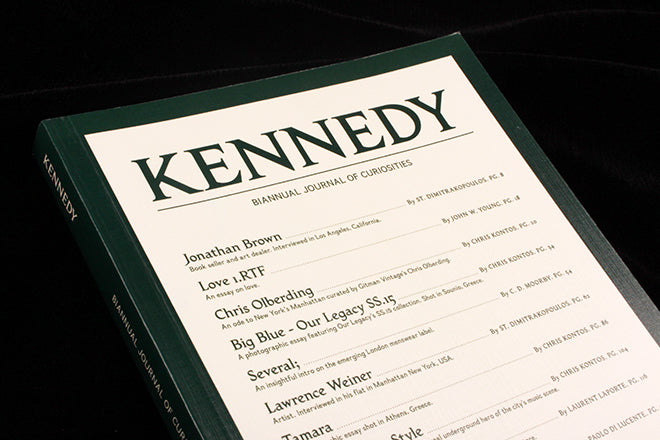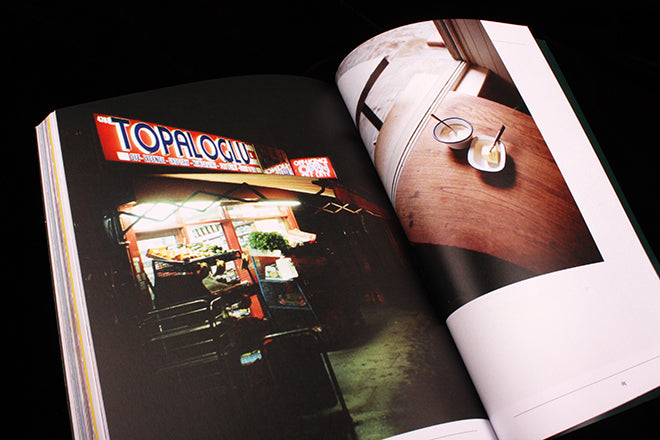
Kennedy #3
People argue that independent magazines have thrived since the economic crash; crowdfunding emerged as an answer to the problem of raising cash for a new project, and young people who can’t afford to intern for free increasingly decide to try their hand at making their own publications. In his opening letter to issue three of Greek Kennedy magazine, editor Chris Kontos describes how he started the publication as a result of economic hardship when he lost his job. Chris believes that creativity is born from boredom and not doing very much – from laziness – and he sees down-time as one of the most important factors in making a magazine. Therefore the people profiled in Kennedy seem to all have one thing in common, and that’s a love of idle time for calm and collected thinking.
Freunde von Freunden’s Frederik Frede highlighted Kennedy as one of his favourite magazines of the moment in our At Work With interview with him earlier this week, and for me, Kennedy’s slow-burning content is a mixture of the kind of profiles you might find in Port and the laid-back philosophy of London-based The Idler. At times some of the wording gets a bit lost in translation, but it’s an elegant and thoughtful publication nonetheless.
 Pocket-sized and book-like in its thickness, Kennedy combines the look of an old-school literary journal with the aesthetic of classic Fantastic Man spreads. I particularly enjoyed the interviews with art dealer Jonathan Brown (above) and the feature on fashion bookshop Comptoir de L’image in Le Marais (below). A slightly soft-porn ‘photo essay’ with hints of old American Apparel campaigns at the centre of the magazine is quite off-putting – a move from a quietly bookish sensibility to a less charming and more swaggering Byronic vibe.
Pocket-sized and book-like in its thickness, Kennedy combines the look of an old-school literary journal with the aesthetic of classic Fantastic Man spreads. I particularly enjoyed the interviews with art dealer Jonathan Brown (above) and the feature on fashion bookshop Comptoir de L’image in Le Marais (below). A slightly soft-porn ‘photo essay’ with hints of old American Apparel campaigns at the centre of the magazine is quite off-putting – a move from a quietly bookish sensibility to a less charming and more swaggering Byronic vibe.

 Sparse quotes on a page with nicely placed photos (above) give a sense of breathing room to the otherwise text-heavy spreads, and a bright yellow background for a feature on DJ Nozaki is a fun departure from the rest of the pared down tones (below).
Sparse quotes on a page with nicely placed photos (above) give a sense of breathing room to the otherwise text-heavy spreads, and a bright yellow background for a feature on DJ Nozaki is a fun departure from the rest of the pared down tones (below).

 Soothing photos of London (above), and a blissfully calm interview with artist Gary Panter at his home in Brooklyn (below) are a return to Kennedy’s slow-burning and thoughtful tone.
Soothing photos of London (above), and a blissfully calm interview with artist Gary Panter at his home in Brooklyn (below) are a return to Kennedy’s slow-burning and thoughtful tone.
 Here’s a publication that you can happily lay back with and read over Sunday brunch; it’s a magazine for the hammock and idle afternoons. For me, there are a few things that could be slightly reconsidered, but Kennedy is proof that strong, enticing publications often emerge when things get tough – and it uses the imagination as a way of fighting back.
Here’s a publication that you can happily lay back with and read over Sunday brunch; it’s a magazine for the hammock and idle afternoons. For me, there are a few things that could be slightly reconsidered, but Kennedy is proof that strong, enticing publications often emerge when things get tough – and it uses the imagination as a way of fighting back.
Design: Commission


